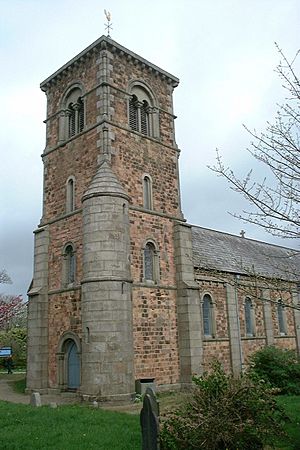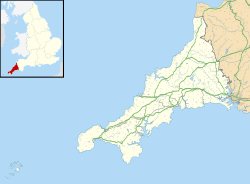All Saints' Church, Tuckingmill facts for kids
Quick facts for kids All Saints’ Church, Tuckingmill |
|
|---|---|

All Saints’ Church, Tuckingmill
|
|
| 50°13′12.3″N 05°17′09″W / 50.220083°N 5.28583°W | |
| OS grid reference | SW 65729 40732 |
| Location | Tuckingmill, Camborne, Cornwall |
| Country | England |
| Denomination | Church of England |
| History | |
| Dedication | All Saints |
| Consecrated | 21 July 1845 |
| Architecture | |
| Heritage designation | Grade II listed |
| Architect(s) | John Hayward of Exeter |
| Style | Norman Revival style |
| Groundbreaking | 31 August 1843 |
| Administration | |
| Parish | Camborne and Tuckingmill |
| Deanery | Carnmarth, North |
| Archdeaconry | Cornwall |
| Diocese | Truro |
| Province | Canterbury |
All Saints’ Church in Tuckingmill is a special old church located on Pendarves Street in Tuckingmill, Camborne, Cornwall. It's part of the Church of England and is considered a 'Grade II listed' building. This means it's an important historical building that needs to be protected.
Contents
History of All Saints’ Church
The first stone for All Saints’ Church was placed on August 31, 1843. A special message was carved into it, saying the church was built "to the Glory of God and for the Salvation of Man." This important step was taken by Baroness Basset of Tehidy.
Building the Church
The church was designed in a style called Norman Revival. This means it looked like older Norman buildings. The architect who designed it was John Hayward from Exeter. The church has a strong granite archway on its north side. The font, which is a basin used for baptisms, came from an old chapel in Menadarva. The church was officially opened and blessed by the Lord Bishop of Exeter on July 21, 1845.
Church Renovations
Later, between 1875 and 1879, the church was updated by an architect named Piers St Aubyn. During this time, the chancel (the area around the altar) was raised and new tiles were added. They also removed a gallery in the tower, replaced the old seats, and fixed the walls and windows. A local builder, Mr. W. May, did the work.
In November 1882, a beautiful new reredos was finished. A reredos is a decorated screen behind the altar. This one had a special border made of "Irish serpentine" stone and was decorated with marble. It was also designed by Piers St Aubyn. The cross on it was made of alabaster, a soft white stone. The church was reopened on February 20, 1879, after these improvements.
Church Community
All Saints’ Church is part of a group of churches that work together. This group includes:
Church Features
Stained Glass Windows
The beautiful east window in the church was made in 1847 by Joseph Bell. The other stained glass windows in the church were added in the 1890s. They were created by a company from Plymouth called Fouracre and Watson, or Fouracre and Son.
The Church Organ
In 1879, a new organ was bought for the church. It cost £120, which would be about £16,000 today. This organ was made by Hele and Sons from Plymouth and had nine "speaking stops," which are different sets of pipes that make various sounds. You can find more details about this organ in the National Pipe Organ Register.
Church Bells
The church tower has a set of eight bells. These bells were made by a company called John Taylor and Company. Six bells were first put in place in 1931. Then, two more bells were added in 1936, making a full set of eight.


